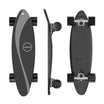I was lucky enough to be a kid right when the Skateboard Revolution of the 1970s took place. Not a teen, a kid. With the introduction of soft, quiet urethane wheels and rapid development in bearings, trucks and deck design, the lowly kids toy with metal wheels that was the “skate board,” cousin to the more popular roller skate, was suddenly reborn as a hip, sleek and fun transportation device that quickly ascended to nearly religious icon status - at least among us kids.
Skateboarding was my first taste of freedom, and along with my BMX bike, it was also a good way to get around. I continued skateboarding up until I graduated from high school, when cars and motorcycles came into better focus. My old deck from those days hangs in the garage now, in pride of place but unused. And now I’ve got a teenager of my own, but he don’t skate (he’s more into playing football). NBD, but I recently temped him with a modernized spin on many teen’s pre-driver’s license dream machine: a motorized skateboard, the $899 Maxfind Belt 77 electric longboard. Of course, I had to personally thoroughly investigate it’s riding qualities as well. It’s my job.

The FF Belt is fairly quiet and the controller makes it easy to ride.
There are two primary ways to motorvate an e-skateboard: Use in-hub motors that fit inside the wheels, or opt for external motors that spin a belt connected to the wheels. The Maxfind FF Belt, clearly, uses belts to get the rear wheels rolling. I’ve ridden both types, and while each has their good and bad points, the belt approach is the most versatile, since it allows for easier wheel removal and exchange. Indeed, while my review FF Belt came with large 105mm urethane wheels, Maxfind also offers some techie LED light-up wheels and a much larger set of pneumatic wheels and tires for the FF. The wheels can be swapped out with normal tools just like on a regular skateboard.

Remote control is simple to use but also includes an informational OLED screen.
The FF Belt’s rear-wheel drive train consists of two 1,500-Watt motors driving each rear wheel independently, negating the need for a complex (and tiny) differential. Each motor mount includes a heavy exposed flywheel for smoothing out power delivery. A plastic cover helps protect the rear wheel drive assembly for the most part and it’s likely a bad idea to let it get clogged up with debris. Under the deck, an unusual set of M III Dual Kingpin trucks allow for precise tuning of turning force and gives the longboard a bit of lift. Like most longboards, the deck has a measure of flex that was evident but was otherwise unobtrusive.

The removable 8.7 amp-hour battery can be swapped in and out quickly.
A 8.7 Amp-hour battery resides under a cover in the 41-inch long deck and it’s easy to remove. That quick-swap capability gives buyers the option to bring along more batteries for more riding range, which Maxfind says is 25 miles on a charge, likely at best. Speed and direction is controlled by a small handheld rechargeable wireless remote with a slick OLED display showing speed, battery status and power mode (1-4). A thumbwheel on the remote controls acceleration and surprisingly effective braking. I also added a pair of rechargeable headlights that mount on small rails at the front of the board for increased visibility. There were no tail lights.
Ride Time

My son gives the FF belt a go while wearing a Unit1 bike helmet with LEDs for increased conspicuity.
I proceeded carefully for my first ride on the FF Belt. I oiled up the bearings on my old board and did a few laps in a nearby parking lot to revive my long-dormant skating muscle memory, and then saddled up the FF Belt and set the motor output level to “1” of four. I wore a full-face Bell Full-10 bike helmet and an armored motorcycle jacket as I had suffered a bad concussion and head injury - despite wearing a helmet, which certainly lessened the effects of the impact - on a similar device in 2020, and wanted to avoid a repeat of that misadventure. My son opted for a Unit1 Faro bike helmet with integrated LEDs for better visibility to others on the road.
I gave the board a push old-school style to get it in motion and eased the thumbwheel forward. The FF Belt smoothly got under way, and after a few minutes, my confidence returned. But not having to power the board myself? Now that’s a different (but fun) feeling.

The Maxfind FF Belt's 105mm wheels (left) dwarf those of a modern manual skateboard.
The FF’s large wheels - about three times the size of normal skate wheels - ate up most bumps in the pavement, but with no kick tail to loft the front wheels over an obstacle, I tried to spot any bits of gravel or debris that might result in a sudden stop. Even at the lowest power setting of 1, the FF Belt gets moving right along. I was still well away from ticking the juice up to turbocharged Level 4.
Eventually, I got the FF Belt out into the bike lane in front of my Portland home and early on a Sunday morning, ticked the controller to Level 2 and eased on the power. Speed built quickly until it closed in on 20 mph, which feels really, really fast for a skateboard. Back in the day, we used to blast down hills on our skateboards, oblivious to the dangers as the speed increased. Helmets? Not back then. I’m not sure how we survived.

Experienced skater Kofi pilots the FF Belt through a local park pathway. Kids have no fear.
After tightening up the trucks for better straight-line stability, I ticked the power level to 3 and went flying down a smooth, freshly paved street at above 20 mph, which was an absolute thrill but also fairly stressful for this mature rider. Getting under way with the board at Level 4 results in truly robust acceleration and for a brief moment the FF Belt touched its top speed of 28 mph, which is the same as a Class 3 e-bike, which rolls on much larger wheels and typically features robust disc brakes. However, the FF Belt did seem at home at that speed, likely due to the nearly four-foot long wheelbase, although the glassy-smooth fresh asphalt was a best-possible scenario for that kind of velocity.
Approaching a stop sign, I rolled back the thumb throttle and eased on the fully variable “brakes,” which is just a reversal of the motor’s energy supply. The FF Belt came to a smooth, controlled stop. Turning around, the FF Belt easily climbed a gentle grade with me aboard, and Maxfind says it can get up a 35% grade, likely not with someone my size on board. Double-tapping the level control button will also allow the board to be driven in “reverse,” or in a sort of “front wheel drive” mode. I preferred the normal rear-wheel drive mode.

Kofi at speed on the FF Belt. It's fast, but also easily controlled.
After I felt complete with my rides on the FF Belt, I turned it over to my teenage son and his friend Kofi (seen in many of the photos here), a proficient skater who often rides miles to school on his deck, same as I did at that age. His take after carving around on the FF Belt? “Weird, but really fun.” A succinct summation.
Conclusions

It's a bit amazing to think these small wheels could get you around without effort, but that's the
When I was a skater kid, we used to imagine what it would be like to have a skateboard with a motor in it. A few lucky kids with handy and clearly misguided parents actually assembled such contraptions from kits you could buy out of the back of magazines like Popular Mechanics and so on. But they were always unreliable, noisy, oil-smoke spewing things powered by tiny 2-stroke motors that could barely get out of their own way, and typically didn’t last long. Still, the dream was real.
The development of lithium batteries, small but potent electric motors and wireless connection tech make those once unlikely motorized skateboards like the Maxfind FF Belt possible - at long last. Could you commute on it? I suppose it’s possible if you’re brave enough. It’s certainly faster than walking - or kicking your manual skateboard down the street. And it was always fun to ride, with unexpected power that was also easily controllable. And as a last-mile micromobility device, it’s tough to beat. While heavier and larger than a regular skateboard, you can still pick it up and hop on a commuter train or pop it into the back seat or trunk of a car. But most of all, it was great fun just cruising around the neighborhood, enjoying movement at a very minimalist level, and carving through turns on the long wheelbase. I never had any problems with the FF Belt, and never ran out the battery despite some longer rides.
While I’ve moved on to bigger, faster machines like cars and motorcycles (and e-bikes), I have to admit that the 10-year-old kid that’s still hiding way back in my memory had a blast riding the Maxfind FF Belt. At least he’s finally smart enough to wear a helmet (and more), and hit the brakes when things get going really fast. Most of the time.
Forbes Review URL: https://www.forbes.com/sites/billroberson/2023/08/31/review-maxfinds-ff-belt-electric-skateboard-is-a-kids-dream-realized/?sh=17b34ccb5885
'Maxfind FF BELT' Shop Now:
https://www.maxfind.com/products/electric-skateboard-ff-belt





















Leave a comment
This site is protected by hCaptcha and the hCaptcha Privacy Policy and Terms of Service apply.